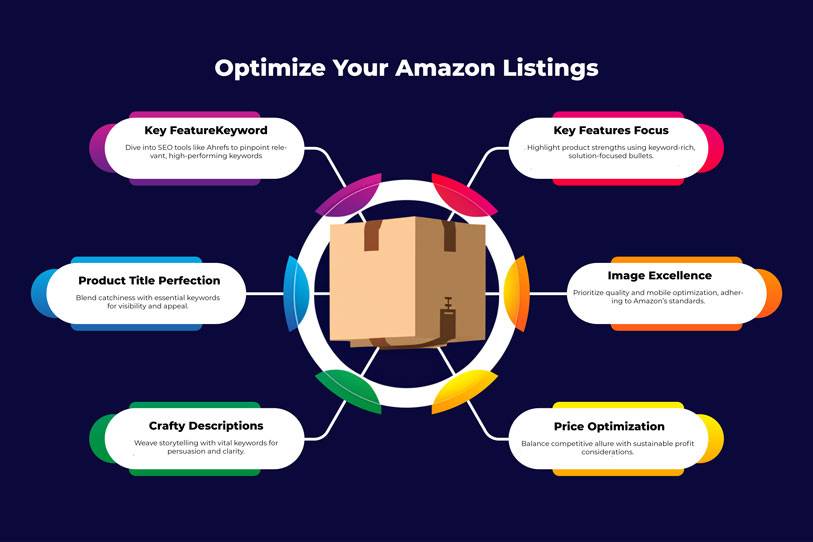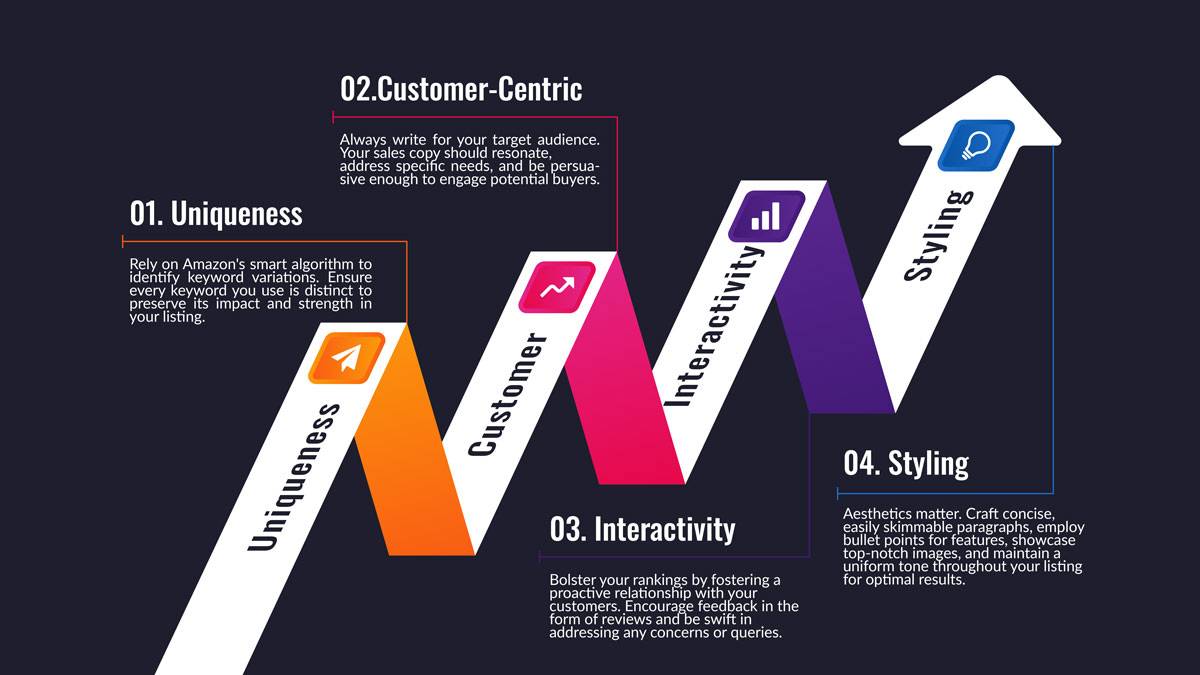Navigating Amazon’s crowded marketplace can feel like finding a needle in a haystack—especially when you’re trying to get your product noticed. But what if there was a GPS for that needle? That’s what Amazon listing SEO is—a precise set of strategies designed to shoot your product to the top of Amazon’s search rankings. Ignoring it is like throwing your products into the haystack and hoping someone stumbles upon them. In this step-by-step guide, we demystify Amazon’s complex algorithm and offer actionable insights you can implement today. Don’t get lost in the shuffle; let’s optimize your listings and turn browsers into buyers.
How Does Amazon SEO Work?
Amazon SEO, also known as Amazon Search Engine Optimization, refers to the process of optimizing product listings on Amazon’s marketplace to improve their visibility and ranking in search results. Here’s an overview of how Amazon SEO works:
- Keyword Research: The first step is to identify relevant keywords that potential customers might use to search for products similar to yours. Tools like Amazon’s Keyword Tool or third-party tools can assist in finding high-volume and relevant keywords.
- Product Title Optimization: The product title is one of the most critical elements for Amazon SEO. It should include relevant keywords, convey product benefits, and adhere to Amazon’s guidelines (e.g., character count limits).
- Bullet Points and Product Description: The bullet points and product description should not only provide accurate information about the product but also include relevant keywords to optimize visibility.
- Backend Search Terms: Amazon provides a backend search terms field where sellers can include additional keywords that might not fit in the product title or bullet points. These keywords are invisible to customers but aid in search results ranking.
- Enhanced Brand Content (EBC) or A+ Content: If you have a brand registry, you can leverage Enhanced Brand Content or A+ Content to enhance your listing with rich media (such as images, videos, and comparison charts) to make it more engaging and informative.
- Product Images: High-quality product images are crucial for user experience and can influence purchase decisions. They should be visually appealing, accurately represent the product, and comply with Amazon’s guidelines.
- Reviews and Ratings: Positive customer reviews and high ratings not only improve sales but also indirectly impact search rankings. Encouraging satisfied customers to leave reviews and providing exceptional customer service can help boost your rankings.
- Pricing and Inventory: Competitive pricing and maintaining sufficient inventory levels are factors Amazon considers when determining rankings. Being out of stock or having significantly higher prices can negatively impact rankings.
- Sponsored Products: As part of Amazon’s advertising platform, sellers can run Sponsored Products campaigns to increase visibility in search results. These ads appear in search results and can lead to improved organic rankings as well.
- Sales Performance: Sales velocity and conversion rates also play a role in Amazon SEO. The more sales you generate and the better your conversion rates, the higher your products are likely to rank.
It’s important to note that Amazon’s algorithm is proprietary and continuously evolving, so keeping up with industry best practices and staying updated on changes is essential for effective Amazon SEO.
Imagine you’re a customer, eager to purchase a new blender. You head over to Amazon and type “best blender for smoothies” into the search bar. Voila! A list of blenders appears. But have you ever stopped to consider why certain products show up first?
It’s not a random game of chance; it’s Amazon SEO at play—a complex system governed by algorithms that determine which products rise to the top. This algorithm factors in multiple variables like relevance, customer behavior, and listing completeness. And if you’re a seller, understanding these factors is your ticket to outperforming competitors and boosting sales.
Amazon’s Search Bar: The Gateway to Mastering Amazon SEO
When users arrive at Amazon, the first thing that often catches their eye is the search bar. While it may seem like just a simple text box, the Amazon search bar is the entry point to a complex algorithm designed to match potential buyers with the most relevant products. Understanding its intricacies is pivotal to mastering Amazon SEO.
Amazon Search Box
Think of the search box as the gateway to Amazon’s vast marketplace. It utilizes complex algorithms that take into account not just keywords but also purchase history, trending products, and more.
As soon as a user starts typing into the search bar, Amazon’s A9 algorithm springs into action, suggesting auto-complete options based on popular searches and individual browsing history. This mechanism doesn’t just make the search experience more seamless; it also provides valuable insight into trending keywords and customer behavior.
Search Filters
Located on the side or top of the search results page, these filters allow users to narrow down options based on categories, brands, price ranges, and customer ratings. Savvy sellers optimize their listings to appear in multiple relevant filters.
Search Results Page
This is where the magic happens. The search results page is a mix of organic listings and sponsored products, ranked according to Amazon’s SEO algorithms. The higher your product ranks here, the more visibility—and potentially more sales—you get.
Sponsored Products
Paid advertising options like Sponsored Products can give your listings an extra push. These appear at the top of search results and are clearly marked as sponsored, but they also must meet Amazon’s SEO criteria to be effective.
Optimize Your Amazon Listings in 7 Steps

Optimize Your Amazon Listings in 7 Steps
Step 1: Conduct Keyword Research
The foundation of any successful Amazon SEO strategy lies in effective keyword research. Utilize tools like Ahrefs to identify high-volume, low-competition keywords that are most relevant to your product.
Step 2: Optimize the Product Title
Your product title is one of the first things potential buyers see. Make it catchy but also packed with essential keywords to improve your search ranking.
Step 3: Optimize Product Descriptions
Don’t underestimate the power of a well-crafted description. Use storytelling techniques while incorporating essential keywords to not only inform but also persuade potential buyers.
- Use A+ Content: Amazon’s A+ Content feature allows for richer product descriptions using images, videos, and more. Utilize this feature for a more engaging product page.
- Use the Manage Your Experiments Tool: Amazon provides this tool to A/B test different elements of your listing, including product descriptions and images. Take advantage of this to find what resonates most with your audience.
Step 4: Optimize Product Key Features
Bullet points highlighting the key features of your product are skimmable and easily digestible. Make sure these points are rich in keywords and focus on solving customer pain points.
- Product Key Features Examples
- Stainless steel blades for long-lasting sharpness
- Energy-efficient design reduces electricity costs
Step 5: Optimize Product Images
High-quality images not only look professional but also enhance the customer experience. Make sure your images comply with Amazon’s guidelines and are optimized for mobile viewing.
Step 6: Optimize Product Search Terms
Behind the scenes in your Amazon Seller Central account, you can add additional search terms that are invisible to customers but are indexed by Amazon’s search algorithm.
- How to Add Search Terms through your Amazon Seller Central Account
- Navigate to the ‘Inventory’ tab.
- Select ‘Manage Inventory.’
- Choose the product you wish to optimize and click ‘Edit.’In the ‘Keywords’ tab, add your chosen search terms.
Step 7: Optimize Product Price
Pricing is more than just a number; it’s a part of your product’s appeal. Use competitive pricing strategies without compromising your profit margins.
4 Essential SEO Best Practices You Should Be Doing on Amazon

1. Don’t Repeat Keywords
Amazon’s algorithm is intelligent enough to recognize keyword variations. Focus on including unique and relevant keywords to avoid dilution of keyword strength.
2. Focus Sales Copy on the Customer
Remember, you’re writing for the customer, not for the algorithm. Your sales copy should solve the customer’s problem or fulfill their need. Keep it engaging and persuasive.
3. Help Improve Your Rankings
Encourage satisfied customers to leave reviews and respond to any queries or complaints promptly. Customer interaction and positive reviews can boost your product’s ranking.
4. Use These Basic Style Tips for Listings
- Keep paragraphs short and scannable
- Use bullet points for features
- Include high-quality images
- Maintain a consistent tone and style
FAQ
Q: What is Amazon Listing SEO?
Amazon Listing SEO refers to the techniques used to improve a product’s visibility on Amazon’s search engine. The better the SEO, the higher the product appears in search results, which can lead to increased sales.
Q: Does SEO Work on Amazon?
Yes, Amazon has its own search algorithm called A9, which determines the ranking of products. Utilizing SEO strategies can significantly improve your product’s visibility and sales on Amazon.
Q: How Much Does Amazon SEO Cost?
The cost of Amazon SEO can vary widely, depending on various factors like the competitiveness of the niche, the features of your listing, and whether you’re doing it yourself or hiring a professional.
Q: Is Amazon SEO the Same as Google SEO?
While both Amazon and Google SEO aim to improve a page’s visibility on their respective search engines, the algorithms and techniques used are different. Amazon focuses more on sales conversion as a ranking factor, whereas Google looks at various other aspects like backlinks, content quality, and user interaction.
Q: What is the purpose of this comprehensive guide?
The purpose of this comprehensive guide is to help you understand how to master the Amazon algorithm and optimize your product listings to skyrocket your rankings on Amazon.
Q: How can I improve my product rankings on Amazon?
To improve your product rankings on Amazon, you need to focus on optimizing your Amazon SEO strategy. This includes optimizing your product listings, utilizing relevant keywords, and using high-quality product images.
Q: Why is product listing optimization important for Amazon rankings?
Product listing optimization is important for Amazon rankings because it helps you optimize your Amazon SEO and increase the visibility of your product in the Amazon search results. By optimizing your product listing, you have a better chance of appearing higher in the search rankings.
Q: How can I optimize my Amazon SEO?
To optimize your Amazon SEO, you need to focus on using relevant keywords in your product title, description, and backend search terms. Additionally, optimizing your product images, generating positive customer reviews, and utilizing Amazon advertising can also help improve your rankings.
Q: What is the Amazon algorithm?
The Amazon algorithm, also known as A9, is the search engine algorithm used by Amazon to determine the rankings of products in its search results. It takes into account various factors such as keyword relevance, sales performance, customer reviews, and product listing optimization.
Q: How can I improve my Amazon keyword research?
To improve your Amazon keyword research, you can use keyword research tools specifically designed for Amazon, analyze competitor listings, and monitor popular search queries on Amazon. By identifying relevant and high-volume keywords, you can optimize your product listings for better rankings.
Q: Can Amazon advertising help improve my product rankings?
Yes, Amazon advertising can help improve your product rankings by increasing your product visibility and generating more sales. Advertising campaigns can drive traffic to your product listing, increase sales velocity, and improve overall product performance, which can positively impact your rankings.
Q: How important is product image optimization in Amazon SEO?
Product image optimization plays a crucial role in Amazon SEO. High-quality product images not only attract potential customers but also convey important information about your product. Optimizing your product images with relevant keywords and following Amazon’s image guidelines can improve your product rankings on Amazon.
Q: What is the role of a seller in Amazon rankings?
As a seller on Amazon, your role is to optimize your product listings, generate sales, and provide excellent customer service. By actively managing your product listings, monitoring customer reviews, and maximizing your sales performance, you can improve your rankings and gain a competitive edge on Amazon.
Q: How can understanding the Amazon search algorithm help me?
Understanding the Amazon search algorithm can help you optimize your product listings and increase your chances of ranking higher in Amazon’s search results. By aligning your strategy with the algorithm’s preferences and factors, you can improve your product visibility, drive more traffic, and ultimately increase your sales on Amazon.
Conclusion
In the rapidly evolving landscape of e-commerce, mastering Amazon SEO is no longer optional—it’s essential. We’ve delved into the inner workings of Amazon’s search algorithm, covered the key steps for optimizing your product listings, and even discussed some general best practices for stellar Amazon SEO. With this guide in hand, you’re well-equipped to climb the ranks and make your products visible to a broader audience.
Remember, Amazon SEO isn’t a “set it and forget it” strategy. It’s an ongoing process that requires regular updates, customer engagement, and a close eye on your competition. But the rewards—a higher rank and ultimately, more sales—are well worth the effort.







